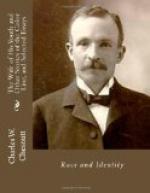By modern research the unity of the human race has been proved (if it needed any proof to the careful or fair-minded observer), and the differentiation of races by selection and environment has been so stated as to prove itself. Greater emphasis has been placed upon environment as a factor in ethnic development, and what has been called “the vulgar theory of race,” as accounting for progress and culture, has been relegated to the limbo of exploded dogmas. One of the most perspicuous and forceful presentations of these modern conclusions of anthropology is found in the volume above quoted, a book which owes its origin to a Boston scholar.
Proceeding then upon the firm basis laid down by science and the historic parallel, it ought to be quite clear that the future American race—the future American ethnic type—will be formed of a mingling, in a yet to be ascertained proportion, of the various racial varieties which make up the present population of the United States; or, to extend the area a little farther, of the various peoples of the northern hemisphere of the western continent; for, if certain recent tendencies are an index of the future it is not safe to fix the boundaries of the future United States anywhere short of the Arctic Ocean on the north and the Isthmus of Panama on the south. But, even with the continuance of the present political divisions, conditions of trade and ease of travel are likely to gradually assimilate to one type all the countries of the hemisphere. Assuming that the country is so well settled that no great disturbance of ratios is likely to result from immigration, or any serious conflict of races, we may safely build our theory of a future American race upon the present population of the country. I use the word “race” here in its popular sense—that of a people who look substantially alike, and are moulded by the same culture and dominated by the same ideals.
By the eleventh census, the ratios of which will probably not be changed materially by the census now under way, the total population of the United States was about 65,000,000, of which about seven million were black and colored, and something over 200,000 were of Indian blood. It is then in the three broad types—white, black and Indian—that the future American race will find the material for its formation. Any dream of a pure white race, of the Anglo-Saxon type, for the United States, may




